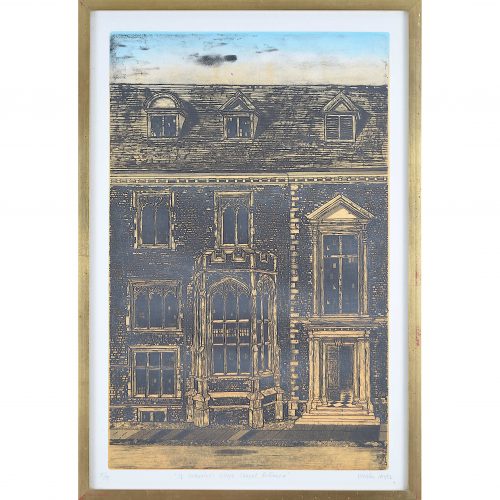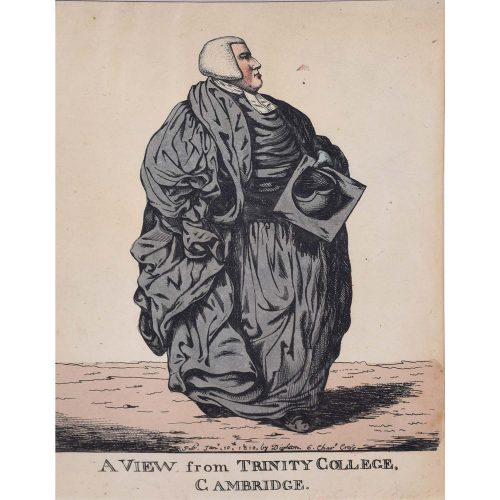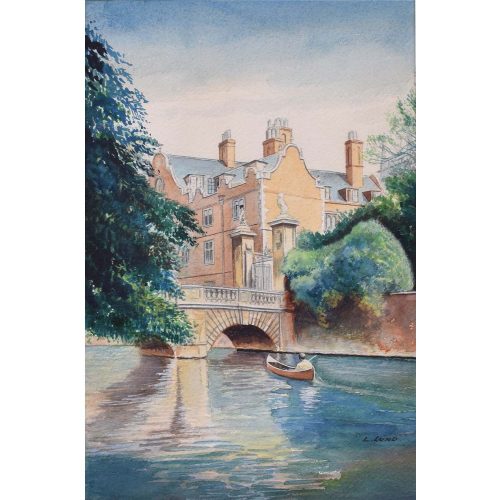-
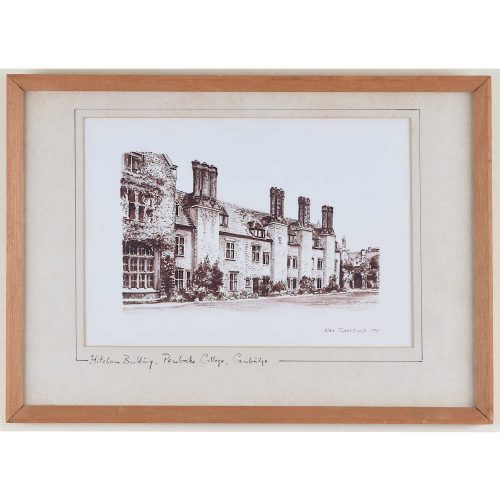
Ray Turrefield (active late 20th century)
Hitcham Building, Pembroke College, Cambridge (1978)
Print 18 x 25 cm Signed and dated lower right. A print of Pembroke College, Cambridge's Hitcham Building. Built in 1659, the Hitcham Building marks the first instance in Pembroke of the Classical Style, which was soon to find full expression in Wren’s Chapel. The building was intended for the Master’s use and was originally connected to the former Master’s Lodge. Both the poet Thomas Gray and the Prime Minister William Pitt lived in the building during their times at Pembroke. Condition: very good. -
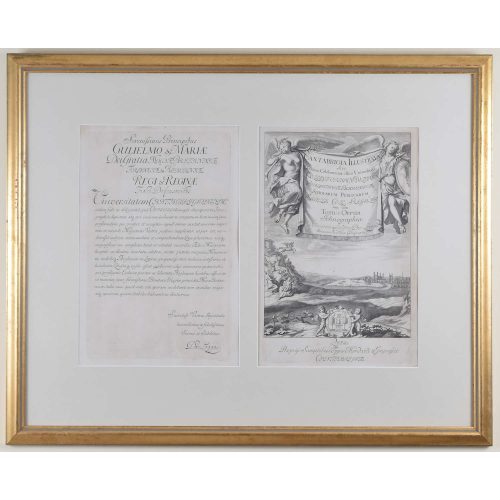 David Loggan (1634-1692) University of Cambridge Frontispiece and Dedication for Cantabrigia Illustrata (1690) Engraving 38 x 55 cm Loggan was born to English and Scottish parents, and was baptised in Danzig in 1634. After studying engraving in Danzig with Willem Hondius (1598-1652 or 1658), he moved to London in the late 1650s, going on to produce the engraved title-page for the folio 1662 Book of Common Prayer. He married in 1663 and moved to Nuffield in Oxfordshire in 1665. Loggan was appointed Public Sculptor to the nearby University of Oxford in the late 1660s, having been commissioned to produce bird’s-eye views of all the Oxford colleges. He lived in Holywell Street as he did this. The 'Oxonia Illustrata' was published in 1675, with the help of Robert White (1645-1704). Following its completion, Loggan began work on his equivalent work for Cambridge; the 'Cantabrigia Illustrata' was finally published in 1690, when he was made engraver to Cambridge University. The 'Oxonia Illustrata' also includes an engraving of Winchester College (Winchester and New College share William of Wykeham as their founder) whilst the 'Cantabrigia Illustrata' includes one of Eton College (which shares its founder, Henry VIII, with King’s College). Bird’s-eye views from this era required a particular talent as an architectural perspectivist; it was not until 1783 that it became possible for artists to ascend via hot air balloons and view the scenes they were depicting from above. Loggan thus had to rely on his imagination in conceiving the views. Loggan’s views constitute the first accurate depictions of the two Universities, in many ways unchanged today. Whilst the Oxford engravings were produced in reasonable numbers and ran to a second edition by Henry Overton (on thicker paper and with a plate number in Roman numerals in the bottom right-hand corner), those of Cambridge were printed in much smaller numbers. The Dutchman Pieter van der Aa published some miniature versions of the engravings for James Beverell’s guidebook to the UK, 'Les Delices de la Grande Bretagne' (c. 1708). The contemporary artist Andrew Ingamells (b.1956) has produced a highly-acclaimed series of etchings which bring Loggan’s original vision up to date.
David Loggan (1634-1692) University of Cambridge Frontispiece and Dedication for Cantabrigia Illustrata (1690) Engraving 38 x 55 cm Loggan was born to English and Scottish parents, and was baptised in Danzig in 1634. After studying engraving in Danzig with Willem Hondius (1598-1652 or 1658), he moved to London in the late 1650s, going on to produce the engraved title-page for the folio 1662 Book of Common Prayer. He married in 1663 and moved to Nuffield in Oxfordshire in 1665. Loggan was appointed Public Sculptor to the nearby University of Oxford in the late 1660s, having been commissioned to produce bird’s-eye views of all the Oxford colleges. He lived in Holywell Street as he did this. The 'Oxonia Illustrata' was published in 1675, with the help of Robert White (1645-1704). Following its completion, Loggan began work on his equivalent work for Cambridge; the 'Cantabrigia Illustrata' was finally published in 1690, when he was made engraver to Cambridge University. The 'Oxonia Illustrata' also includes an engraving of Winchester College (Winchester and New College share William of Wykeham as their founder) whilst the 'Cantabrigia Illustrata' includes one of Eton College (which shares its founder, Henry VIII, with King’s College). Bird’s-eye views from this era required a particular talent as an architectural perspectivist; it was not until 1783 that it became possible for artists to ascend via hot air balloons and view the scenes they were depicting from above. Loggan thus had to rely on his imagination in conceiving the views. Loggan’s views constitute the first accurate depictions of the two Universities, in many ways unchanged today. Whilst the Oxford engravings were produced in reasonable numbers and ran to a second edition by Henry Overton (on thicker paper and with a plate number in Roman numerals in the bottom right-hand corner), those of Cambridge were printed in much smaller numbers. The Dutchman Pieter van der Aa published some miniature versions of the engravings for James Beverell’s guidebook to the UK, 'Les Delices de la Grande Bretagne' (c. 1708). The contemporary artist Andrew Ingamells (b.1956) has produced a highly-acclaimed series of etchings which bring Loggan’s original vision up to date. -
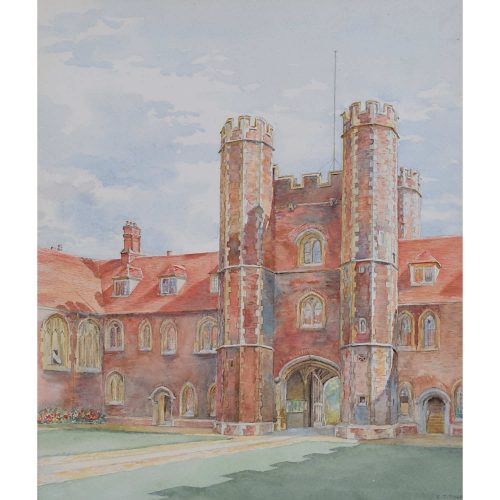
E. T. Talbot
St John's College, Cambridge, showing the First Court and Chapel
Watercolour 30 x 25 cm A richly-coloured watercolour painting of the First Court of St John's. First Court was built in 1511-20 to the south of the old Hospital of St John the Evangelist, and was designed to contain living quarters, chapel, library, hall, and kitchens. The version of First Court which Talbot paints looks markedly different to the college today - the chapel on the far left of the picture was demolished after the new chapel was completed in 1869. -
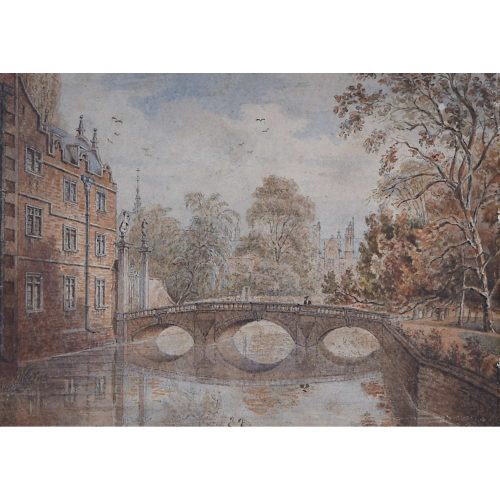
Sarah Orange (19th century)
The Kitchen Bridge, St John's College, Cambridge (c. 1830)
Watercolour 14 x 20 cm Provenance: Bene't Gallery, Cambridge. This 19th century watercolour depicts the Kitchen Bridge at John's. A scholar in gown and mortarboard stands alone in the bridge's centre, gazing meditatively into the glassy water below. -
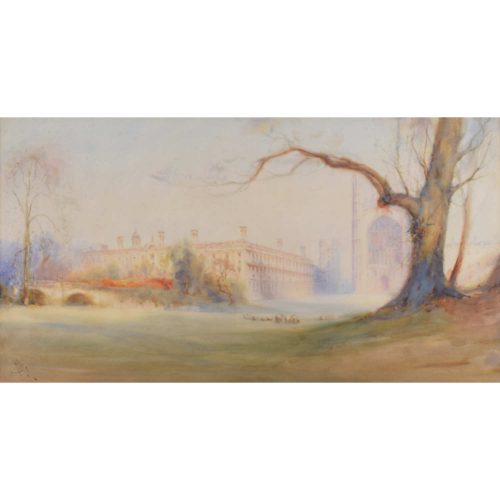 Charles March Gere R.A. R.W.S. (1869 - 1957) King's College from the Backs Watercolour 36 x 69 cm Monogrammed lower left. An atmospheric watercolour of one of Cambridge's most exalted sights: King's College chapel from the Backs, together with Clare College. Charles March Gere R.A. R.W.S. was an English painter, illustrator of books, and stained glass and embroidery designer associated with the Arts and Crafts movement.
Charles March Gere R.A. R.W.S. (1869 - 1957) King's College from the Backs Watercolour 36 x 69 cm Monogrammed lower left. An atmospheric watercolour of one of Cambridge's most exalted sights: King's College chapel from the Backs, together with Clare College. Charles March Gere R.A. R.W.S. was an English painter, illustrator of books, and stained glass and embroidery designer associated with the Arts and Crafts movement. -
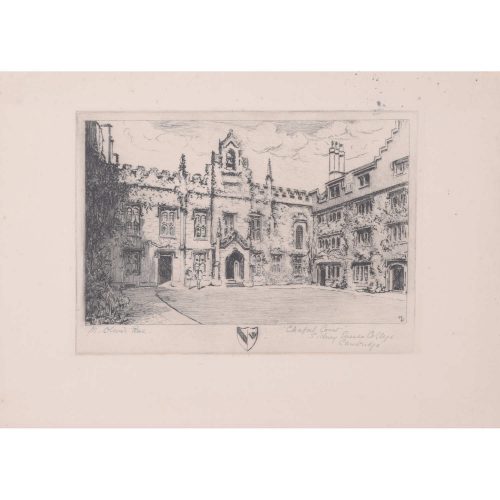
Mabel Oliver Rae
Chapel Court, Sidney Sussex College, Cambridge
Etching, circa 1920 12 x 17 cm Hand-signed in pencil lower left, and titled in pencil lower right. Signed "MR" in plate. Mabel Oliver Rae was born in Cambridge, Cambridgeshire, and trained at the Slade School of Fine Art between 1888 and 1890. Rae is known for her skilled etchings of various rural scenes and townscapes, particularly those of the colleges of Oxford and Cambridge. She signed works with the pseudonym 'M.Oliver Rae', a ruse to conceal the fact she was a female artist, so as not to reduce her chances with commercial dealers and agents. Condition: Generally very good. -
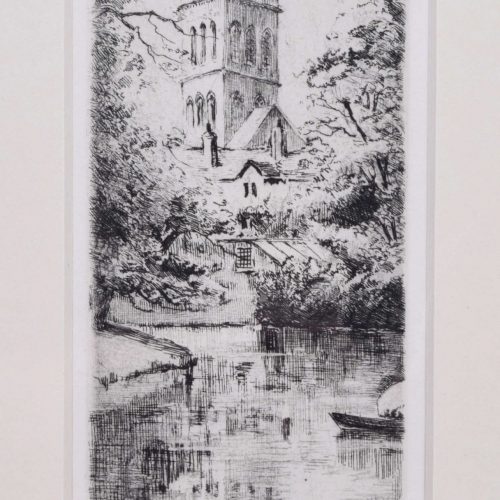
Mabel Oliver Rae
Chapel Tower of St John's College, Cambridge
Etching, circa 1920 19 x 7 cm Hand-signed in pencil lower left, and titled in pencil lower right. Signed "MR" in plate. Mabel Oliver Rae was born in Cambridge, Cambridgeshire, and trained at the Slade School of Fine Art between 1888 and 1890. Rae is known for her skilled etchings of various rural scenes and townscapes, particularly those of the colleges of Oxford and Cambridge. She signed works with the pseudonym 'M.Oliver Rae', a ruse to conceal the fact she was a female artist, so as not to reduce her chances with commercial dealers and agents. Condition: Generally very good. -
Out of stock
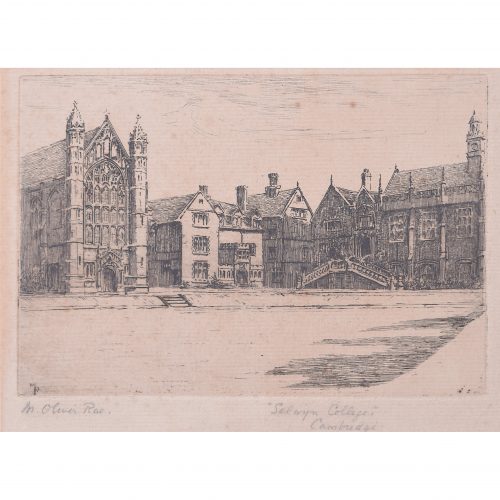
Mabel Oliver Rae
Selwyn College, Cambridge
Etching, circa 1920 19 x 29 cm Hand-signed in pencil lower left, and titled in pencil lower right. Initialled 'MR' in plate. Mabel Oliver Rae was born in Cambridge, Cambridgeshire, and trained at the Slade School of Fine Art between 1888 and 1890. Rae is known for her skilled etchings of various rural scenes and townscapes, particularly those of the colleges of Oxford and Cambridge. She signed works with the pseudonym 'M.Oliver Rae', a ruse to conceal the fact she was a female artist, so as not to reduce her chances with commercial dealers and agents. Condition: Good. Even age toning, a little spotting, generally good. -
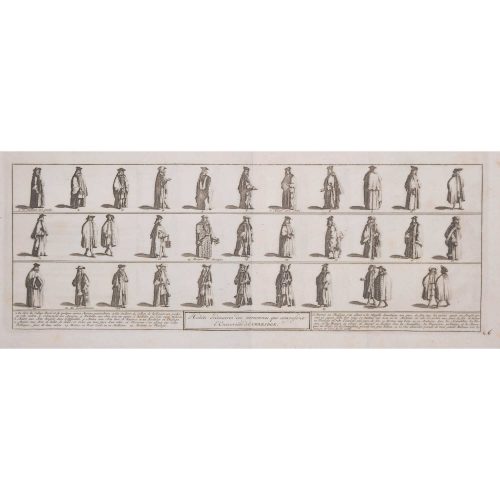
Pieter van der Aa (1659-1733), after David Loggan (1634-1692)
The Costumes of the University of Cambridge
Engraving, 14 x 36 cm Early 18th century This engraving by van der Aa (based on a prior design by David Loggan) illustrates the various forms of academic dress worn by members of the University of Cambridge. Pieter van der Aa of Leiden was a Dutch publisher best known for preparing maps and atlases, though he also printed editions of foreign bestsellers and illustrated volumes. He is noted for the many engravings he produced after David Loggan's series of Oxford and Cambridge colleges and costumes. Condition: Generally very good; slight age toning, and spotting to margins. -
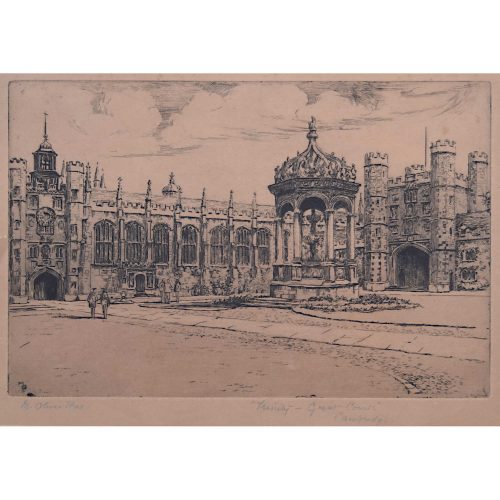
Mabel Oliver Rae
Great Court, Trinity College, Cambridge
Etching, circa 1920 20 x 27cm Signed lower left. Mabel Oliver Rae was born in Cambridge, Cambridgeshire, and trained at the Slade School of Fine Art between 1888 and 1890. Rae is known for her skilled etchings of various rural scenes and townscapes, particularly those of the colleges of Oxford and Cambridge. She signed works with the pseudonym 'M.Oliver Rae', a ruse to conceal the fact she was a female artist, so as not to reduce her chances with commercial dealers and agents. Condition: Generally very good, slight discolouration to margins - which will not be visible under mount. -
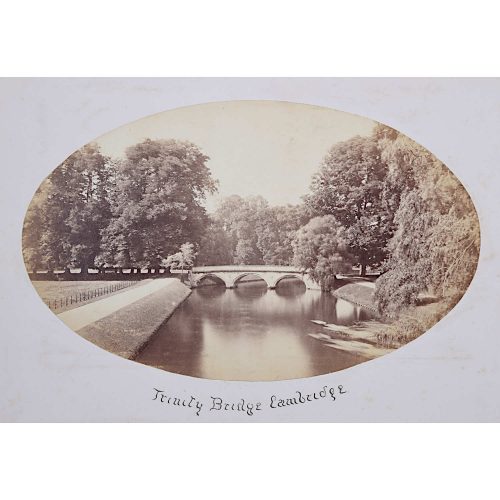
Trinity Bridge, Cambridge
Albumen print of a photograph, circa 1850 Mounted to board and inscribed 'Trinity Bridge Cambridge'. Trinity Bridge is a stone built tripled-arched road bridge across the River Cam. It was built from Portland stone in 1765 to the designs of James Essex to replace an earlier bridge built in 1651, and is a Grade I listed building. Trinity College is a constituent college of the University of Cambridge, and was founded in 1546 by King Henry VIII. Trinity is one of the oldest and largest colleges in Cambridge, with the largest financial endowment of any college at either Cambridge or Oxford. Trinity has some of the most distinctive architecture within Cambridge, with its Great Court reputed to be the largest enclosed courtyard in Europe. Condition: generally very good. If you’d like to know more, please email info@manningfineart.co.uk or call us on 07929 749056. -
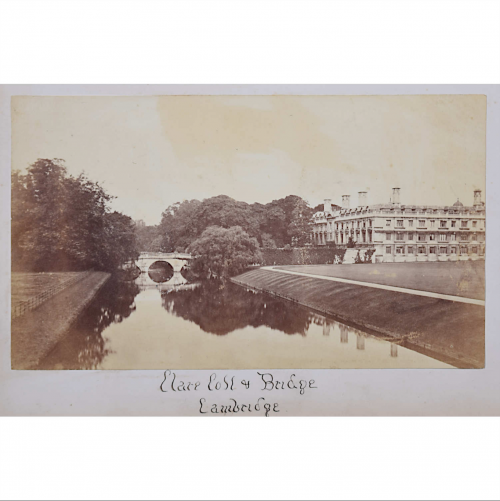
Clare College and Bridge, Cambridge
Albumen print of a photograph, circa 1850 Mounted to board and inscribed 'Clare Coll + Bridge Cambridge'. Clare College is a constituent college of the University of Cambridge in Cambridge. The college was founded in 1326 as University Hall, making it the second-oldest surviving college of the University after Peterhouse. It was refounded in 1338 as Clare Hall after an endowment from Elizabeth de Clare, and took on its current name in 1856. Clare is famous for its chapel choir and for its gardens on The Backs, overlooking the River Cam. Condition: generally very good, slight toning to sky. If you’d like to know more, please email info@manningfineart.co.uk or call us on 07929 749056. -
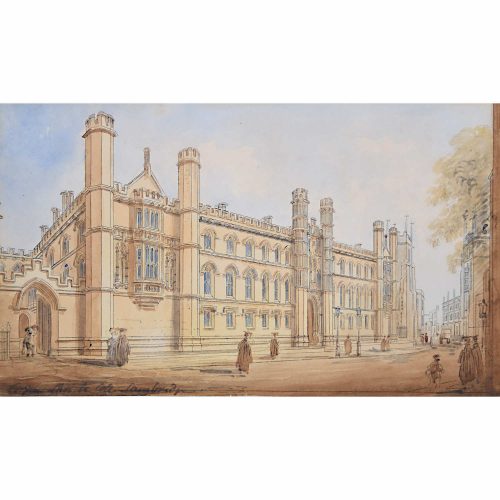
View of Corpus Christi College, Cambridge
Watercolour on paper 13.5 x 23cm A charming view of Corpus Christi College and assorted denizens of Cambridge. The college is notable as the only one founded by Cambridge townspeople; it was established in 1352 by the Guild of Corpus Christi and the Guild of the Blessed Virgin Mary, making it the sixth-oldest college in Cambridge. With around 250 undergraduates and 200 postgraduates, it also has the second smallest student body of the traditional colleges of the University, after Peterhouse. The College has traditionally been one of the more academically successful colleges in the University of Cambridge. It also ranks among the wealthiest Cambridge colleges in terms of fixed assets, being exceptionally rich in silver. Unsigned; labelled 'Corpus Christi Coll. Cambridge' in ink, lower left. If you’d like to know more, please email info@manningfineart.co.uk or call us on 07929 749056. -
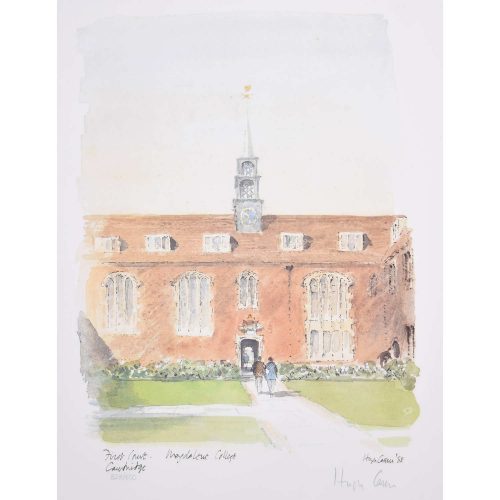
Hugh Casson (1910 - 1999)
Magdalene College, Cambridge, First Court
Signed in pencil, and numbered 328/500 from the limited edition of 500. 34x25cm From Casson’s ever-popular Oxford and Cambridge series of prints. Sir Hugh Casson was educated at Eastbourne College; St John’s College, Cambridge; and the Bartlett School of Architecture. Trained in the 1930s in the early modernist style, he taught at the Cambridge School of Architecture. After employment as a camoufleur during World War 2 by the Air Ministry, in 1948 he was appointed as director of architecture for the Festival of Britain. A close friend of the Royal Family, he undertook designs for the 1953 coronation, designed the interior of the Royal Yacht Britannia (“The overall idea was to give the impression of a country house at sea”), and taught the Prince of Wales to paint in watercolours. Amongst his architectural achievements are the Elephant House at London Zoo, the 1978 redevelopment of Bristol Docks, the Raised Faculty Building for The University of Cambridge, and a building for the Royal College of Art. He published a number of illustrated books, of which Casson’s Oxford and Casson’s Cambridge are probably the best known. A limited edition series of prints was produced from the paintings. Condition: excellent. If you’d like to know more, please email info@manningfineart.co.uk or call us on 07929 749056. -
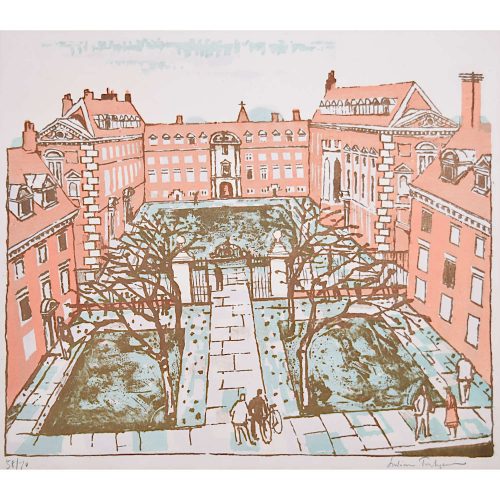
Julian Trevelyan (1910-1988) St Catharine's College, Cambridge
Etching and aquatint, signed, numbered 58/70 41 x 47 cm Nephew of the historian G M Trevelyan, Julian Trevelyan was educated at Bedales and then at Trinity College, Cambridge, where he read English. After moving to Paris, Trevelyan studied engraving at Stanley William Hayter’s school, working alongside artists such as Max Ernst, Joan Miro and Pablo Picasso. He married the potter Ursula Darwin in 1934, and in 1935 they moved to Hammersmith, buying Durham Wharf beside the River Thames which was Trevelyan’s studio – and home – for the rest of his life. His wartime service was – like so many artists – as a camoufleur. A Royal Engineer from 1940-43, he served in North Africa and Palestine, forcing the German Afrika Korps to use resources against a dummy army whilst real tanks were disguised as more harmless equipment. In the desert, nothing could be hidden - but it could be disguised. Following the dissolution of his marriage in 1950, he married the painter Mary Fedden. Teaching at Chelsea School of Art, Trevelyan eventually became head of the Etching Department and his pupils included David Hockney and Peter Ackroyd. Condition: Some toning to paper. If you’d like to know more, please email info@manningfineart.co.uk or call us on 07929 749056. -
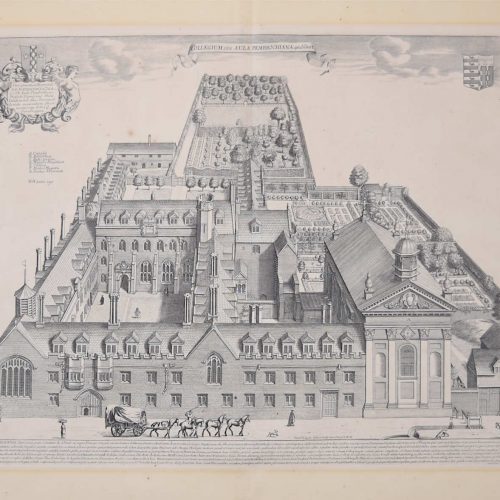
David Loggan (1634-1692)
Pembroke College, Cambridge
Engraving, 1690 36x45cm Loggan was born to English and Scottish parents, and was baptised in Danzig in 1634. After studying engraving in Danzig with Willem Hondius (1598-1652 or 1658), he moved to London in the late 1650s, going on to produce the engraved title-page for the folio 1662 Book of Common Prayer. He married in 1663 and moved to Nuffield in Oxfordshire in 1665. Loggan was appointed Public Sculptor to the nearby University of Oxford in the late 1660s, having been commissioned to produce bird’s-eye views of all the Oxford colleges. He lived in Holywell Street as he did this. The 'Oxonia Illustrata' was published in 1675, with the help of Robert White (1645-1704). Following its completion, Loggan began work on his equivalent work for Cambridge; the 'Cantabrigia Illustrata' was finally published in 1690, when he was made engraver to Cambridge University. The 'Oxonia Illustrata' also includes an engraving of Winchester College (Winchester and New College share William of Wykeham as their founder) whilst the 'Cantabrigia Illustrata' includes one of Eton College (which shares its founder, Henry VIII, with King’s College). Bird’s-eye views from this era required a particular talent as an architectural perspectivist; it was not until 1783 that it became possible for artists to ascend via hot air balloons and view the scenes they were depicting from above. Loggan thus had to rely on his imagination in conceiving the views. Loggan’s views constitute the first accurate depictions of the two Universities, in many ways unchanged today. Whilst the Oxford engravings were produced in reasonable numbers and ran to a second edition by Henry Overton (on thicker paper and with a plate number in Roman numerals in the bottom right-hand corner), those of Cambridge were printed in much smaller numbers. The Dutchman Pieter van der Aa published some miniature versions of the engravings for James Beverell’s guidebook to the UK, 'Les Delices de la Grande Bretagne' (c. 1708). The contemporary artist Andrew Ingamells (b.1956) has produced a highly-acclaimed series of etchings which bring Loggan’s original vision up to date. If you’d like to know more, please email info@manningfineart.co.uk or call us on 07929 749056. Condition: Some staining to margins outside platemark. -
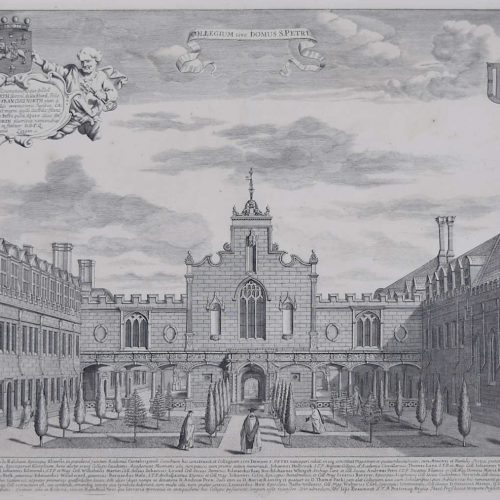
David Loggan (1634-1692)
Peterhouse, Cambridge
Engraving, 1690 30x40cm, framed Loggan was born to English and Scottish parents, and was baptised in Danzig in 1634. After studying engraving in Danzig with Willem Hondius (1598-1652 or 1658), he moved to London in the late 1650s, going on to produce the engraved title-page for the folio 1662 Book of Common Prayer. He married in 1663 and moved to Nuffield in Oxfordshire in 1665. Loggan was appointed Public Sculptor to the nearby University of Oxford in the late 1660s, having been commissioned to produce bird’s-eye views of all the Oxford colleges. He lived in Holywell Street as he did this. The 'Oxonia Illustrata' was published in 1675, with the help of Robert White (1645-1704). Following its completion, Loggan began work on his equivalent work for Cambridge; the 'Cantabrigia Illustrata' was finally published in 1690, when he was made engraver to Cambridge University. The 'Oxonia Illustrata' also includes an engraving of Winchester College (Winchester and New College share William of Wykeham as their founder) whilst the 'Cantabrigia Illustrata' includes one of Eton College (which shares its founder, Henry VIII, with King’s College). Bird’s-eye views from this era required a particular talent as an architectural perspectivist; it was not until 1783 that it became possible for artists to ascend via hot air balloons and view the scenes they were depicting from above. Loggan thus had to rely on his imagination in conceiving the views. Loggan’s views constitute the first accurate depictions of the two Universities, in many ways unchanged today. Whilst the Oxford engravings were produced in reasonable numbers and ran to a second edition by Henry Overton (on thicker paper and with a plate number in Roman numerals in the bottom right-hand corner), those of Cambridge were printed in much smaller numbers. The Dutchman Pieter van der Aa published some miniature versions of the engravings for James Beverell’s guidebook to the UK, 'Les Delices de la Grande Bretagne' (c. 1708). The contemporary artist Andrew Ingamells (b.1956) has produced a highly-acclaimed series of etchings which bring Loggan’s original vision up to date. If you’d like to know more, please email info@manningfineart.co.uk or call us on 07929 749056. Condition: Generally excellent. -
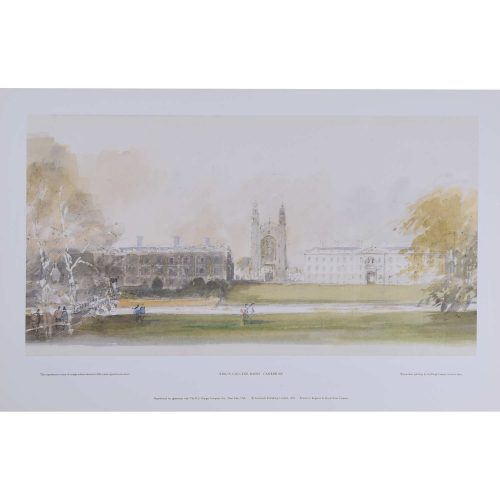 Sir Hugh Casson (1910-1999) King's College from the Backs 22 x 41cm Unsigned proof print Sir Hugh Casson was educated at Eastbourne College, St John’s College Cambridge and the Bartlett School of Architecture. Trained in the 1930s in the early modernist style, he taught at the Cambridge School of Architecture. After employment as a camoufleur during World War 2 by the Air Ministry, in 1948 he was appointed as director of architecture for the Festival of Britain. A close friend of the Royal Family, he undertook designs for the 1953 coronation, designed the interior of the Royal Yacht Britannia (“The overall idea was to give the impression of a country house at sea”), and taught the Prince of Wales to paint in watercolours. Amongst his architectural achievements are the Elephant House at London Zoo, the 1978 redevelopment of Bristol Docks, the Raised Faculty Building for The University of Cambridge, and a building for the Royal College of Art. He published a number of illustrated books, of which Casson’s Oxford and Casson’s Cambridge are probably the best known. A limited edition series of prints was produced from the paintings. King's College is a constituent college of the University of Cambridge in Cambridge, England. Formally The King's College of Our Lady and Saint Nicholas in Cambridge, the college lies beside the River Cam and faces out onto King's Parade in the centre of the city.
Sir Hugh Casson (1910-1999) King's College from the Backs 22 x 41cm Unsigned proof print Sir Hugh Casson was educated at Eastbourne College, St John’s College Cambridge and the Bartlett School of Architecture. Trained in the 1930s in the early modernist style, he taught at the Cambridge School of Architecture. After employment as a camoufleur during World War 2 by the Air Ministry, in 1948 he was appointed as director of architecture for the Festival of Britain. A close friend of the Royal Family, he undertook designs for the 1953 coronation, designed the interior of the Royal Yacht Britannia (“The overall idea was to give the impression of a country house at sea”), and taught the Prince of Wales to paint in watercolours. Amongst his architectural achievements are the Elephant House at London Zoo, the 1978 redevelopment of Bristol Docks, the Raised Faculty Building for The University of Cambridge, and a building for the Royal College of Art. He published a number of illustrated books, of which Casson’s Oxford and Casson’s Cambridge are probably the best known. A limited edition series of prints was produced from the paintings. King's College is a constituent college of the University of Cambridge in Cambridge, England. Formally The King's College of Our Lady and Saint Nicholas in Cambridge, the college lies beside the River Cam and faces out onto King's Parade in the centre of the city. -
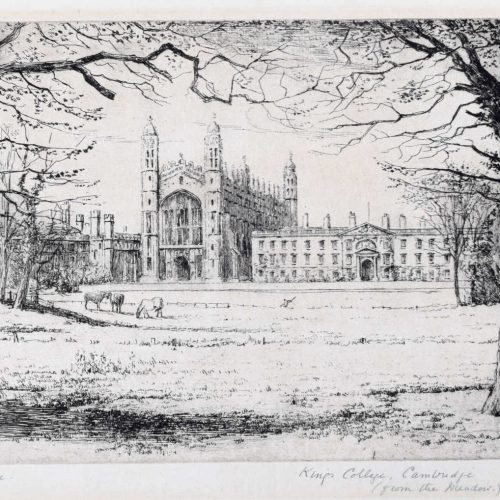
Mabel Oliver Rae (1868-1956)
Kings College Cambridge from the Meadow (c.1920)
27 x 39.5 cm Etching Unmounted Mabel Oliver Rae was born in Cambridge, Cambridgeshire, and trained at the Slade School of Fine Art between 1888 and 1890. Rae is known for her skilled etchings of various rural scenes and townscapes, particularly those of the colleges of Oxford and Cambridge. She signed works with the pseudonym 'M.Oliver Rae', a ruse to conceal the fact she was a female artist, so as not to reduce her chances with commercial dealers and agents. Condition: Generally very good. Mount burn to edges which will be hidden under a new mount. Tiny spot to bottom right margin below tree as visible. -

Hanslip Fletcher (1874-1955) St John's College, Cambridge
20x30cm Pen and Wash If you are interested email info@manningfineart.co.uk or call us on 07929 749056. Condition: Good. -
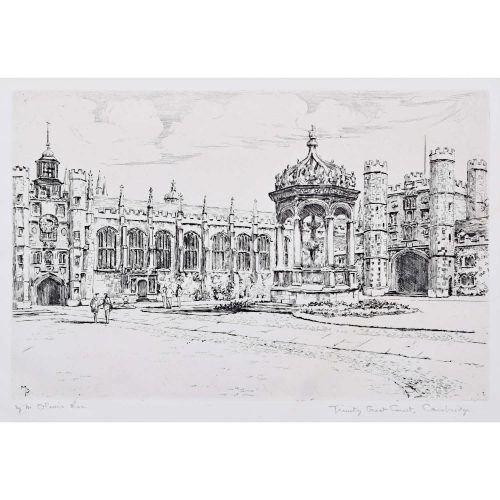
Mabel Oliver Rae ((1868-1956) Trinity College Cambridge Great Court
Etching 20x27 cm The rich tones of the etchings make them as popular today as when they were first made. Click here for biographical details and other pictures by the artist. If you are interested email info@manningfineart.co.uk or call us on 07929 749056. Condition: Generally very good. -
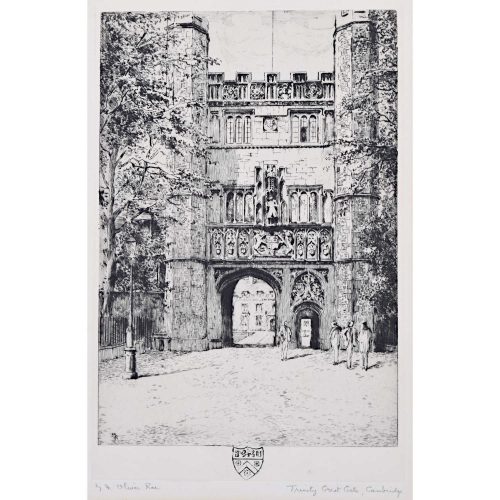
Mabel Oliver Rae ((1868-1956) Trinity College Cambridge Great Gate
Etching 28x18 cm The rich tones of the etchings make them as popular today as when they were first made. Click here for biographical details and other pictures by the artist. If you are interested email info@manningfineart.co.uk or call us on 07929 749056. Condition: Generally very good. -
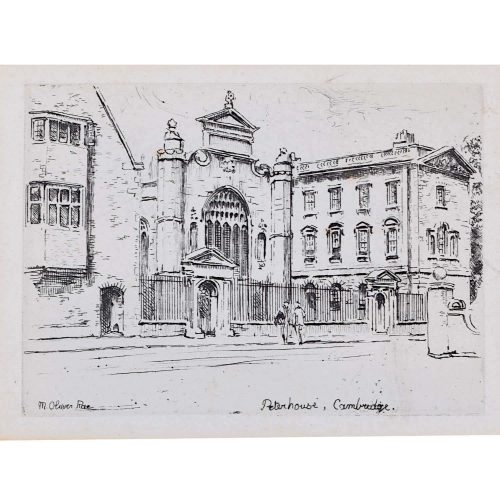
Mabel Oliver Rae (1868-1956) Peterhouse Cambridge
Etching 11x9 cm The rich tones of the etchings make them as popular today as when they were first made. Click here for biographical details and other pictures by the artist. If you are interested email info@manningfineart.co.uk or call us on 07929 749056. Condition: Generally very good. -
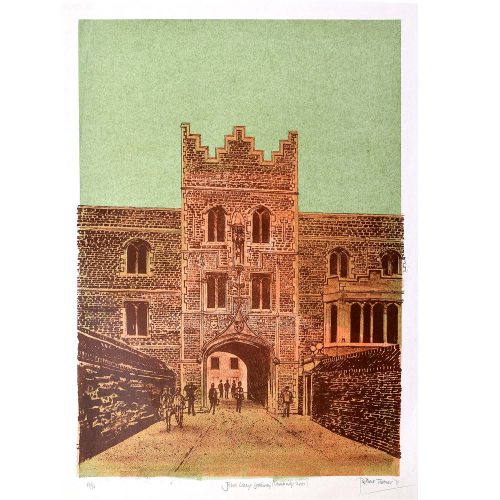
Robert Tavener (1920-2004) Jesus College Gateway Cambridge
Signed and numbered 10/50 Lithograph 54.5 x 39 cm c. 1970 For other works by Robert Tavener and biographical details click here. If you are interested email info@manningfineart.co.uk or call us on 07929 749056. Condition: Good. -

James Bolivar Manson (1879 - 1945) St John's College, Cambridge
Watercolour 29 x 40 cm Signed lower right. A wintry view of St John's College, Cambridge. The chapel tower nestles behind bare trees, set against a white sky. Manson was an artist who worked at the Tate Gallery and was its Director from 1930 to 1938. His time there was clouded by his frustrated ambitions as a painter and his descent into alcoholism. His professional career began as an office boy - leaving Alleyn's School in Dulwich at 16 - with the publisher George Newnes, and then as a bank clerk. He simultaneously studied painting at Heatherley School of Fine Art, commencing in 1890, and then Lambeth School of Art - much encouraged by Lilian Laugher, a violinist who came to stay in the Manson household. He married her in 1903 - the same year he abandoned his bank job. They moved to Paris for a year. Manson shared a studio with Jacob Epstein, who became a lifelong friend. When they returned to London, Manson joined the Camden Town Group, becoming Secretary. Lilian was a close friend of the Director of the Tate and ensured that Manson, aged 33, became Tate Clerk. Manson continued to paint feverishly at the weekend. The Tate website describes Manson as its 'least succesful' director. Kenneth Clark described him with "a flushed face, white hair and a twinkle in his eye; and this twinkling got him out of scrapes that would have sunk a worthier man without trace." His painting continued to show promise, and he joined the London Group in 1914 and showed with the New England Art Club from 1915. His first solo show was at the Leicester Galleries in 1923 and he became a member of the NEAC in 1927. He attended a dinner at the Hotel George V in Paris in 1938 to celebrate the British Exhibition at the Louvre. Clive Bell wrote to his wife, "Manson arrived at the déjeuner given by the minister of Beaux Arts fantastically drunk - punctuated the ceremony with cat-calls and cock-a-doodle-doos, and finally staggered to his feet, hurled obscene insults at the company in general and the minister in particular, and precipitated himself on the ambassadress, Lady Phipps, some say with amorous intent; others with lethal intent." Bell concluded: "The guests fled, ices uneaten, coffee undrunk... I hope an example will be made, and that they will seize the opportunity for turning the sot out of the Tate, not because he is a sot, but because he has done nothing but harm to modern painting." The Director of the Tate was arbiter as to whether imported items amounted to art (which would make them exempt from customs duty). This caused controversy when Peggy Guggenheim imported sculpture by Marcel Duchamp and others. Manson pronounced Constantin Brâncuși's Sculpture for the Blind (a large, smooth, egg-shaped marble) to be "idiotic" and "not art", and therefore subject to duty. Letters were written to the press and the matter reached the House of Commons, where Manson was criticised and eventually had to back down. He retired at the age of 58. By his own account, "my doctor has warned me that my nerves will not stand any further strain... I have begun to have blackouts, in which my actions become automatic. Sometimes these periods last several hours.... I had one of these blackouts at an official luncheon in Paris recently, and startled guests by suddenly crowing like a cock...." His successor was Sir John Rothenstein, who discovered that the staff referred to artwork in the basement as 'Director's Stock'. It transpired that Manson had been selling it to boost his salary. His work now hangs in the Tate, as well as in many other galleries in Britain and abroad. Condition: Good. If you’d like to know more, please email info@manningfineart.co.uk or call us on 07929 749056. Click here for more views of St John's College, Cambridge. -
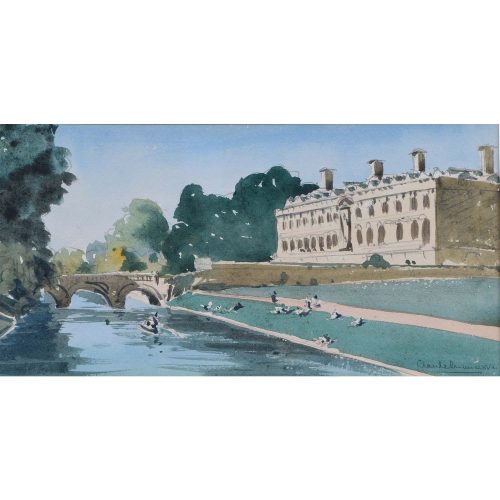
Claude Muncaster Cambridge
Watercolour 14x27cm Signed lower right Muncaster’s watercolours capture the English countryside feel with great competence. Click here for biographical details and other works by the artist. If you are interested email info@manningfineart.co.uk or call us on 07929 749056. Condition: Good. -

Anonymous St. John’s College, Cambridge
Watercolour 32x24.5cm If you are interested email info@manningfineart.co.ukor call us on 07929 749056. Condition: Good. -
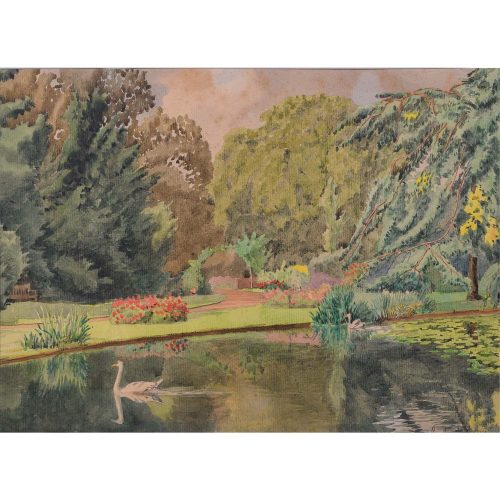
Major F A Molony
Fellows’ Garden Emmanuel College Cambridge (19th century)
Watercolour 22x30cm In the Royal Engineers, Major F A Molony was an accomplished watercolourist who published several views of Cambridge. If you are interested email info@manningfineart.co.ukor call us on 07929 749056. Condition: Good. -
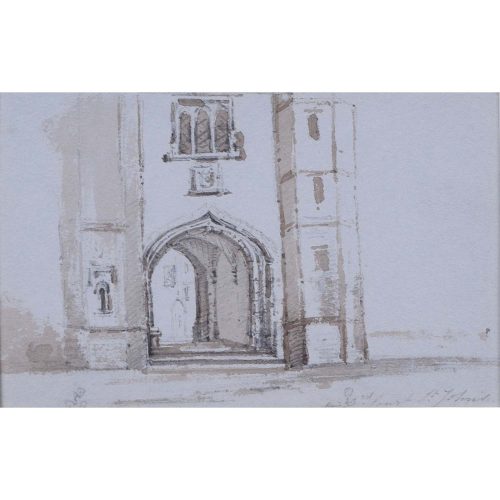
Marianne James
Entrance to Third Court St. John’s College Cambridge (c.1810-1860)
Watercolour & pencil Signed 10×17cm If you are interested email info@manningfineart.co.uk or call us on 07929 749056. Condition: Good. -
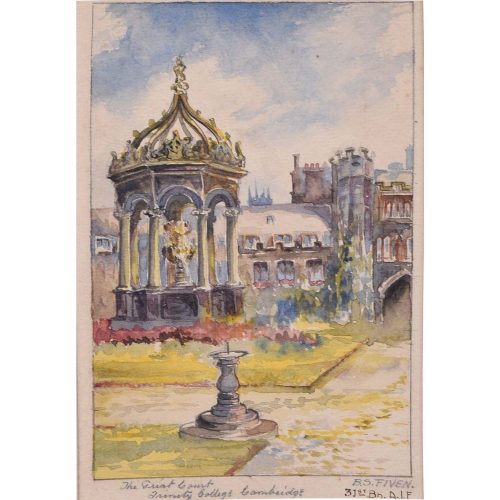
Bertie Studley Fiven (Australian, 1889-1958) Trinity College, Cambridge
14.5 x 9.5 cm Watercolour c. 1917 Born in Carlton, Victoria, Australia, Fiven enlisted in 1915 in C Company of the 31st Australian Infantry Battalion in July 1915. In November 1915 he embarked on either HMAT Wandilla or HMAT Bakara from Melbourne. Whilst on board the '31st Recorder' newspaper was produced (it ran to only one issue, published in the middle of the Indian Ocean on 1st December 1915) and Fiven produced the illustration for the front cover. He then served in Egypt defending the Suez Canal from the Turks. The Battalion then served in France in the Battle of Fromelles in July 1916, suffering 500 casualties and serving no further part in the war until 1917, where it was on the edge of the Battle of Passchendale in September. The Battalion being disbanded in March 1919, Fiven returned to Australia, returning as a Lieutenant on 15 May 1919 to the relief of his mother Mary and his sweetheart May Moore - whom he married on 16 August 1919. There was a policy of rotating troops away from the front line, and Fiven will have spent some rest time in Cambridge when he painted this picture. He died in Heidelberg in Australia in 1958. If you are interested email info@manningfineart.co.ukor call us on 07929 749056. Condition: Good. -
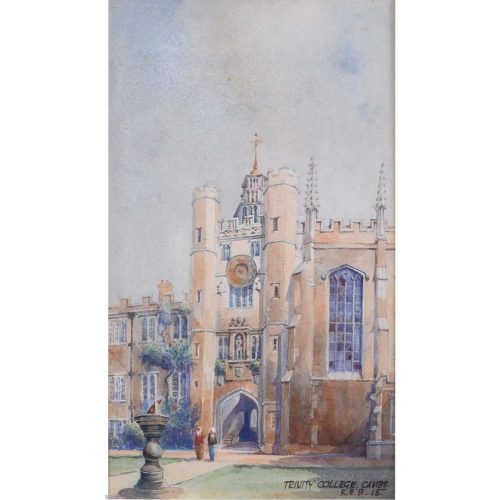
R.H.B Trinity College, Cambridge
22.5x13cm 1915 If you are interested email info@manningfineart.co.ukor call us on 07929 749056. Condition: Good. -
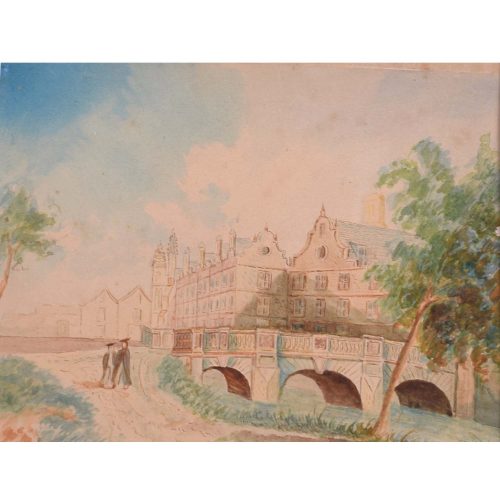
Anonymous
St John’s College, Cambridge
Watercolour and pencil 13x18cm Probably early 19th century. This watercolour depicts St John’s prior to construction of Hutchinson’s 1831 New Court buildings; two figures wearing gowns and square caps are engaged in conversation by the Wren Bridge. If you are interested email info@manningfineart.co.uk or call us on 07929 749056. Condition: Good. -
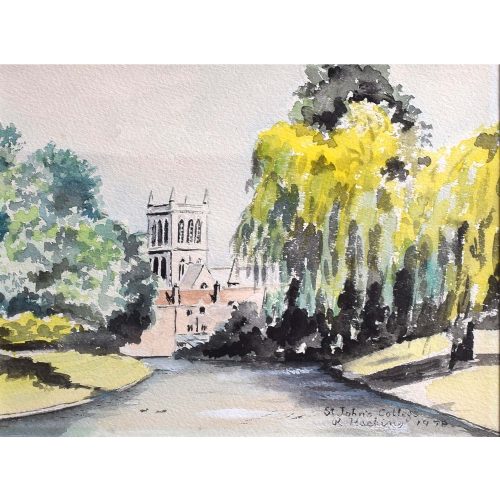
R Hacking
St. John’s College, Cambridge (1978)
Watercolour 17x25cm If you are interested email info@manningfineart.co.ukor call us on 07929 749056. Condition: Good. -
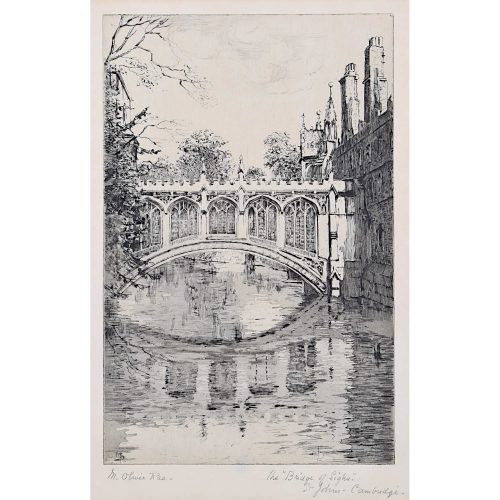
Mabel Oliver Rae (1868-1956) Bridge of Sighs St John's College Cambridge
Etching 30x19 cm Click here for biographical details and other pictures by the artist. If you are interested email info@manningfineart.co.uk or call us on 07929 749056. Condition: Good. -
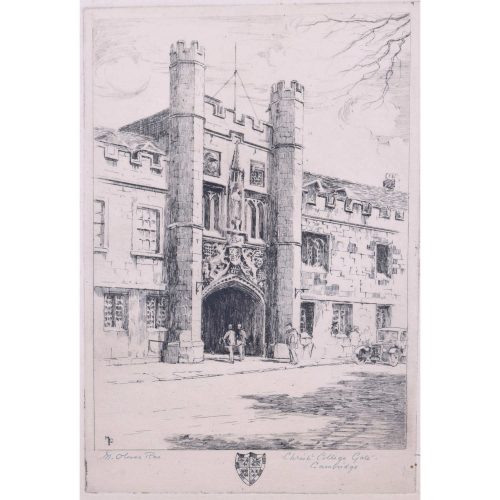
Mabel Oliver Rae (1868-1956) Christ's College Cambridge Great Gate
Etching 27x18cm Click here for biographical details and other pictures by the artist. If you are interested email info@manningfineart.co.uk or call us on 07929 749056. Condition: Good. -
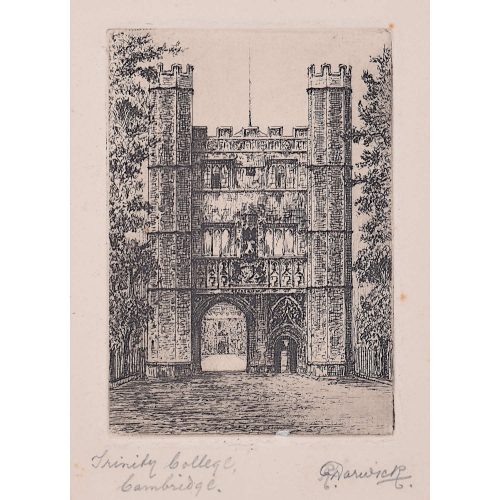
R Warwick (British, fl c. 1900-1930) Trinity College Cambridge, Great Gate
Etching size: 9x6cm; sheet size 15x12cm On deckle-edged paper If you are interested email info@manningfineart.co.uk or call us on 07929 749056. Condition: Generally good condition, some foxing to sheet, but scarcely within image area. -
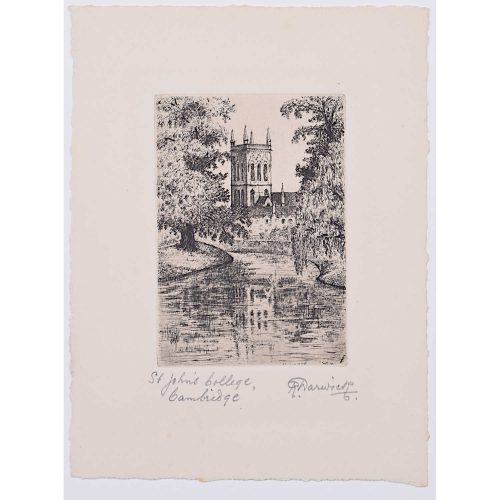
R Warwick (British, fl c. 1900-1930) St John's College Cambridge
Etching size: 9x6cm; sheet size 15x12cm On deckle-edged paper If you are interested email info@manningfineart.co.uk or call us on 07929 749056. Condition: Generally very good condition.

